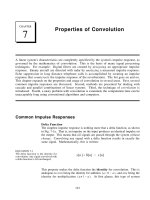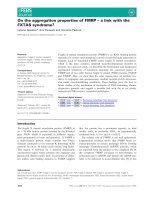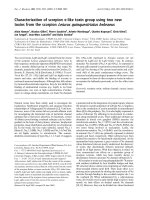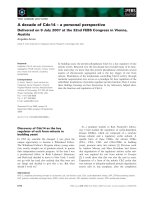Properties of Convolution
Bạn đang xem bản rút gọn của tài liệu. Xem và tải ngay bản đầy đủ của tài liệu tại đây (278.7 KB, 18 trang )
123
CHAPTER
7
EQUATION 7-1
The delta function is the identity for
convolution. Any signal convolved with
a delta function is left unchanged.
x[n] ( *[n] ' x[n]
Properties of Convolution
A linear system's characteristics are completely specified by the system's impulse response, as
governed by the mathematics of convolution. This is the basis of many signal processing
techniques. For example: Digital filters are created by designing an appropriate impulse
response. Enemy aircraft are detected with radar by analyzing a measured impulse response.
Echo suppression in long distance telephone calls is accomplished by creating an impulse
response that counteracts the impulse response of the reverberation. The list goes on and on.
This chapter expands on the properties and usage of convolution in several areas. First, several
common impulse responses are discussed. Second, methods are presented for dealing with
cascade and parallel combinations of linear systems. Third, the technique of correlation is
introduced. Fourth, a nasty problem with convolution is examined, the computation time can be
unacceptably long using conventional algorithms and computers.
Common Impulse Responses
Delta Function
The simplest impulse response is nothing more that a delta function, as shown
in Fig. 7-1a. That is, an impulse on the input produces an identical impulse on
the output. This means that all signals are passed through the system without
change. Convolving any signal with a delta function results in exactly the
same signal. Mathematically, this is written:
This property makes the delta function the identity for convolution. This is
analogous to zero being the identity for addition , and one being the(a %0 ' a)
identity for multiplication . At first glance, this type of system(a×1 ' a)
The Scientist and Engineer's Guide to Digital Signal Processing124
EQUATION 7-2
A system that amplifies or attenuates has
a scaled delta function for an impulse
response. In this equation, k determines
the amplification or attenuation.
x[n] (k *[n] ' kx[n]
EQUATION 7-3
A relative shift between the input and
output signals corresponds to an impulse
response that is a shifted delta function.
The variable, s, determines the amount of
shift in this equation.
x[n] ( *[n %s] ' x[n %s]
may seem trivial and uninteresting. Not so! Such systems are the ideal for
data storage, communication and measurement. Much of DSP is concerned
with passing information through systems without change or degradation.
Figure 7-1b shows a slight modification to the delta function impulse
response. If the delta function is made larger or smaller in amplitude, the
resulting system is an amplifier or attenuator, respectively. In equation
form, amplification results if k is greater than one, and attenuation results
if k is less than one:
The impulse response in Fig. 7-1c is a delta function with a shift. This results
in a system that introduces an identical shift between the input and output
signals. This could be described as a signal delay, or a signal advance,
depending on the direction of the shift. Letting the shift be represented by the
parameter, s, this can be written as the equation:
Science and engineering are filled with cases where one signal is a shifted
version of another. For example, consider a radio signal transmitted from
a remote space probe, and the corresponding signal received on the earth.
The time it takes the radio wave to propagate over the distance causes a
delay between the transmitted and received signals. In biology, the
electrical signals in adjacent nerve cells are shifted versions of each other,
as determined by the time it takes an action potential to cross the synaptic
junction that connects the two.
Figure 7-1d shows an impulse response composed of a delta function plus a
shifted and scaled delta function. By superposition, the output of this system
is the input signal plus a delayed version of the input signal, i.e., an echo.
Echoes are important in many DSP applications. The addition of echoes is a
key part in making audio recordings sound natural and pleasant. Radar and
sonar analyze echoes to detect aircraft and submarines. Geophysicists use
echoes to find oil. Echoes are also very important in telephone networks,
because you want to avoid them.
Chapter 7- Properties of Convolution 125
Sample number
-2 -1 0 1 2 3 4 5 6
-2
-1
0
1
2
Sample number
-2 -1 0 1 2 3 4 5 6
-2
-1
0
1
2
Sample number
-2 -1 0 1 2 3 4 5 6
-2
-1
0
1
2
Sample number
-2 -1 0 1 2 3 4 5 6
-2
-1
0
1
2
FIGURE 7-1
Simple impulse responses using shifted and scaled delta functions.
a. Identity
The delta function is the identity for
convolution. Convolving a signal with
the delta function leaves the signal
unchanged. This is the goal of systems
that transmit or store signals.
b. Amplification & Attenuation
Increasing or decreasing the amplitude
of the delta function forms an impulse
response that amplifies or attenuates,
respectively. This impulse response will
amplify the signal by 1.6.
c. Shift
Shifting the delta function produces a
corresponding shift between the input
and output signals. Depending on the
direction, this can be called a delay or
an advance. This impulse response
delays the signal by four samples.
d. Echo
A delta function plus a shifted and
scaled delta function results in an echo
being added to the original signal. In
this example, the echo is delayed by four
samples and has an amplitude of 60% of
the original signal.
AmplitudeAmplitudeAmplitude Amplitude
Calculus-like Operations
Convolution can change discrete signals in ways that resemble integration and
differentiation. Since the terms "derivative" and "integral" specifically refer
to operations on continuous signals, other names are given to their discrete
counterparts. The discrete operation that mimics the first derivative is called
the first difference. Likewise, the discrete form of the integral is called the
The Scientist and Engineer's Guide to Digital Signal Processing126
EQUATION 7-4
Calculation of the first difference. In
this relation, is the original signal,x[n]
and is the first difference. y[n]
y[n] ' x[n] & x[n &1]
Sample number
-2 -1 0 1 2 3 4 5 6
-2
-1
0
1
2
Sample number
-2 -1 0 1 2 3 4 5 6
-2
-1
0
1
2
FIGURE 7-2
Impulse responses that mimic calculus operations.
a. First Difference
This is the discrete version of the first
derivative. Each sample in the output
signal is equal to the difference between
adjacent samples in the input signal. In
other words, the output signal is the
slope of the input signal.
b. Running Sum
The running sum is the discrete version
of the integral. Each sample in the
output signal is equal to the sum of all
samples in the input signal to the left.
Note that the impulse response extends
to infinity, a rather nasty feature.
AmplitudeAmplitude
running sum. It is also common to hear these operations called the discrete
derivative and the discrete integral, although mathematicians frown when
they hear these informal terms used.
Figure 7-2 shows the impulse responses that implement the first difference and
the running sum. Figure 7-3 shows an example using these operations. In 7-
3a, the original signal is composed of several sections with varying slopes.
Convolving this signal with the first difference impulse response produces the
signal in Fig. 7-3b. Just as with the first derivative, the amplitude of each
point in the first difference signal is equal to the slope at the corresponding
location in the original signal. The running sum is the inverse operation of the
first difference. That is, convolving the signal in (b), with the running sum's
impulse response, produces the signal in (a).
These impulse responses are simple enough that a full convolution program is
usually not needed to implement them. Rather, think of them in the alternative
mode: each sample in the output signal is a sum of weighted samples from the
input. For instance, the first difference can be calculated:
That is, each sample in the output signal is equal to the difference between two
adjacent samples in the input signal. For instance, . Ity[40] ' x[40] & x[39]
should be mentioned that this is not the only way to define a discrete
derivative. Another common method is to define the slope symmetrically
around the point being examined, such as: . y[n] ' ( x[n%1] &x[n&1] )/2
Chapter 7- Properties of Convolution 127
FIGURE 7-3
Example of calculus-like operations. The
signal in (b) is the first difference of the
signal in (a). Correspondingly, the signal is
(a) is the running sum of the signal in (b).
These processing methods are used with
discrete signals the same as differentiation
and integration are used with continuous
signals.
Sample number
0 10 20 30 40 50 60 70 80
-0.2
-0.1
0.0
0.1
0.2
Sample number
0 10 20 30 40 50 60 70 80
-2.0
-1.0
0.0
1.0
2.0
First
Difference
Running
Sum
a. Original signal
b. First difference
AmplitudeAmplitude
EQUATION 7-5
Calculation of the running sum. In this
relation, is the original signal, and x[n] y[n]
is the running sum.
y[n] ' x[n] % y[n &1]
Using this same approach, each sample in the running sum can be calculated
by summing all points in the original signal to the left of the sample's location.
For instance, if is the running sum of , then sample is found byy[n] x[n] y[40]
adding samples through . Likewise, sample is found by addingx[0] x[40] y[41]
samples through . Of course, it would be very inefficient to calculatex[0] x[41]
the running sum in this manner. For example, if has already beeny[40]
calculated, can be calculated with only a single addition:y[41]
. In equation form:y[41] ' x[41] %y[40]
Relations of this type are called recursion equations or difference
equations. We will revisit them in Chapter 19. For now, the important idea
to understand is that these relations are identical to convolution using the
impulse responses of Fig. 7-2. Table 7-1 provides computer programs that
implement these calculus-like operations.
The Scientist and Engineer's Guide to Digital Signal Processing128
100 'Calculation of the running sum
110 Y[0] = X[0]
120 FOR I% = 1 TO N%-1
130 Y[I%] = Y[I%-1] + X[I%]
140 NEXT I%
100 'Calculation of the First Difference
110 Y[0] = 0
120 FOR I% = 1 TO N%-1
130 Y[I%] = X[I%] - X[I%-1]
140 NEXT I%
Table 7-1
Programs for calculating the first difference and running sum. The original signal is held in X[ ], and the
processed signal (the first difference or running sum) is held in Y[ ]. Both arrays run from 0 to N%-1.
Sample number
-20 -15 -10 -5 0 5 10 15 20
-0.1
0.0
0.1
0.2
0.3
0.4
b. Square pulse
Sample number
-20 -15 -10 -5 0 5 10 15 20
-0.1
0.0
0.1
0.2
0.3
0.4
a. Exponential
FIGURE 7-4
Typical low-pass filter kernels. Low-pass
filter kernels are formed from a group of
adjacent positive points that provide an
averaging (smoothing) of the signal. As
discussed in later chapters, each of these filter
kernels is best for a particular purpose. The
exponential, (a), is the simplest recursive
filter. The rectangular pulse, (b), is best at
reducing noise while maintaining edge
sharpness. The sinc function in (c), a curve of
the form: , is used to separate onesin(x)/(x)
band of frequencies from another.
Sample number
-20 -15 -10 -5 0 5 10 15 20
-0.1
0.0
0.1
0.2
0.3
0.4
c. Sinc
Amplitude Amplitude
Amplitude
Low-pass and High-pass Filters
The design of digital filters is covered in detail in later chapters. For now, be
satisfied to understand the general shape of low-pass and high-pass filter
kernels (another name for a filter's impulse response). Figure 7-4 shows
several common low-pass filter kernels. In general, low-pass filter kernels are
composed of a group of adjacent positive points. This results in each sample
in the output signal being a weighted average of many adjacent points from the
input signal. This averaging smoothes the signal, thereby removing high-
frequency components. As shown by the sinc function in (c), some low-pass
filter kernels include a few negative valued samples in the tails. Just as in
analog electronics, digital low-pass filters are used for noise reduction, signal
separation, wave shaping, etc.
Chapter 7- Properties of Convolution 129
Sample number
-20 -15 -10 -5 0 5 10 15 20
-0.50
0.00
0.50
1.00
1.50
b. Square pulse
Sample number
-20 -15 -10 -5 0 5 10 15 20
-0.5
0.0
0.5
1.0
1.5
a. Exponential
FIGURE 7-5
Typical high-pass filter kernels. These are
formed by subtracting the corresponding low-
pass filter kernels in Fig. 7-4 from a delta
function. The distinguishing characteristic of
high-pass filter kernels is a spike surrounded
by many adjacent negative samples.
Sample number
-20 -15 -10 -5 0 5 10 15 20
-0.50
0.00
0.50
1.00
1.50
c. Sinc
Amplitude Amplitude
Amplitude
The cutoff frequency of the filter is changed by making filter kernel wider or
narrower. If a low-pass filter has a gain of one at DC (zero frequency), then
the sum of all of the points in the impulse response must be equal to one. As
illustrated in (a) and (c), some filter kernels theoretically extend to infinity
without dropping to a value of zero. In actual practice, the tails are truncated
after a certain number of samples, allowing it to be represented by a finite
number of points. How else could it be stored in a computer?
Figure 7-5 shows three common high-pass filter kernels, derived from the
corresponding low-pass filter kernels in Fig. 7-4. This is a common strategy
in filter design: first devise a low-pass filter and then transform it to what you
need, high-pass, band-pass, band-reject, etc. To understand the low-pass to
high-pass transform, remember that a delta function impulse response passes
the entire signal, while a low-pass impulse response passes only the low-
frequency components. By superposition, a filter kernel consisting of a delta
function minus the low-pass filter kernel will pass the entire signal minus the
low-frequency components. A high-pass filter is born! As shown in Fig. 7-5,
the delta function is usually added at the center of symmetry, or sample zero
if the filter kernel is not symmetrical. High-pass filters have zero gain at DC
(zero frequency), achieved by making the sum of all the points in the filter
kernel equal to zero.

![Tài liệu Báo cáo khoa học: The stereochemistry of benzo[a]pyrene-2¢-deoxyguanosine adducts affects DNA methylation by SssI and HhaI DNA methyltransferases pptx](https://media.store123doc.com/images/document/14/br/gc/medium_Y97X8XlBli.jpg)







